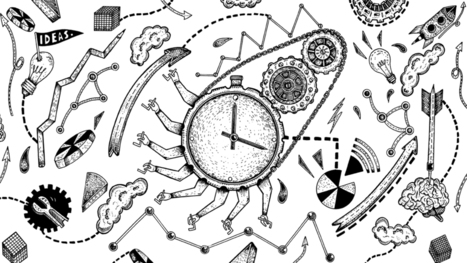 Your new post is loading...
 Your new post is loading...
With all the “be your best self now!” hullabaloo, we can get overwhelmed with what we think we should be doing. We can drive ourselves crazy thinking about all the things we could do to make ourselves smarter, stronger, better. Not long ago, I actually found myself surrounded by whiteboards sketching out all of my self-improvement plans for the year, kanban board style. And while goals and growth plans are great, sometimes the best ideas for change come from an awareness outside of ourselves. I know, it sounds weird to hear a leadership coach telling you to look for something outside of yourself. I’m all about tuning into that courageous and all-knowing voice who can tout your fabulousness–it’s good stuff. But let’s get real: Sometimes the only way to get perspective about what needs to change comes from an outside perspective. Yes, believe it or not, there is often a gap between who we desire and think we are presenting to the world, and the way others see us. Turns out that when you ask the people around you–the ones who see you in action every day and are impacted by the choices you make–where you can grow, their ideas might be a little different than your own.
Via The Learning Factor
You probably know that powerful people receive dozens, if not hundreds, of unsolicited requests every day. And at networking events or speaking engagements, the most influential folks in the room usually have to fight back a scrum of people hoping to get a word in or hand off a business card. To get on their radar, you have to do more than cold email and hope for the best, or push your way to the front of the line at industry mixers. The better way to connect with superstars isn’t to get in front of them and ask them for things. As Duke University professor and author Dorie Clark put it, “The world is competing for the attention of the most successful people,” she wrote for Harvard Business Review. “If you want to meet them–and break through and build a lasting connection–the best strategy is to make them come to you.” Here are a few ways to do that.
Via The Learning Factor
Traditional goal setting focuses on the beginning and the end—start strong and keep your eye on the prize. Unfortunately, that process doesn’t work for every kind of goal, says Scott Young, author of How to Change a Habit. “A lot has been taught around the classic self-help style of Zig Ziglar or Tony Robbins where you have a clear goal, you visualize it, write it down, and focus on the starting point,” says Young, cofounder of the career development course Top Performer. “Some goals, though, aren’t clearly sequential.” The middle can and should be your starting point when you’re setting a goal where you’re unclear of the level you can achieve within a particular timeframe. This is especially the case with daunting, unfamiliar goals where you don’t yet have a strong sense of the big picture.
Via The Learning Factor
You’ve probably experienced the frustration of being distracted at work. Perhaps you were pulled into a never-ending Slack discussion, and when it finally ended you struggled to focus on the task you were working on. Or a coworker criticized you, and now you can’t stop replaying his comments in your head. It’s totally normal to lose focus after a period of time (which is why you should be taking regular breaks). But if you find yourself easily distracted throughout the day, you might want to consider tweaking some of your morning habits. They probably won’t eliminate all distractions, but you’ll at least start your workday strong building a good foundation for the rest of the day.
Via The Learning Factor
You’ve probably been taught that giving compliments build relationships. In the self-help classic How to Win Friends and Influence People, Dale Carnegie stressed the importance of “giving sincere and honest appreciation” to others in life and work. He’s not wrong, but the thing is that showing real appreciation is difficult to do. How many times has someone given you a “compliment” and you just know they’re trying to get something from you? Compliments can easily veer into flattery and feel insincere, leaving the recipient wondering about the giver’s hidden agenda. Here’s what it takes to avoid all that–it’s easier than you think.
Via The Learning Factor
Automation isn’t a simple struggle between people and technology, with the two sides competing for jobs. The more we rely on robots, artificial intelligence (AI), and machine learning, the clearer it’s become just how much we need social scientists and humanities experts–not the reverse. These four skills in particular are all unique to us humans, and will arguably rise in value in the coming years, as more and more companies realize they need the best of both worlds to unleash the potential from both humans and machines. AI and machine learning are extremely useful for solving straightforward, predictable problems and finding patterns no human would ever be able to spot in big data pools. But they’re less helpful in sussing out issues where it’s not a given what the problem actually consists of. Say a patient gradually stops taking her medication, and an algorithm picks up on that fall-off early on. That’s great, but you still need a human being to ask why and contextualize the reasons–with a full understanding of what it means to live with chronic illness. For instance, is the patient simply forgetting to take her medication, or actively choosing not to? Is there an alternative remedy that suits the patient’s priorities and lifestyle?
Via The Learning Factor
One of the most common questions I get asked by senior managers is “How can we find more innovative people?” I know the type they have in mind — someone energetic and dynamic, full of ideas and able to present them powerfully. It seems like everybody these days is looking for an early version of Steve Jobs. Yet in researching my book, Mapping Innovation, I found that most great innovators were nothing like the mercurial stereotype. In fact, almost all of them were kind, generous, and interested in what I was doing. Many were soft-spoken and modest. You would notice very few of them in a crowded room. So the simplest answer is that you need to start by empowering the people already in your organization. But to do that, you need to take responsibility for creating an environment in which your people can thrive. That’s no simple task, and most managers have difficulty with it. Nevertheless, by following a few simple principles you can make a huge difference.
Via The Learning Factor
How long should an eLearning module be? What is the ideal length? Can people concentrate for longer than their shoe size in minutes? What is the average attention span? Attention span is the amount of concentrated time a person can spend on a task without becoming distracted. Common estimates for sustained attention to a freely chosen task range from about five minutes for a two-year-old child, to a maximum of around 20 minutes in older children and adults. (www.Wikipedia.org) Recently I had to sit through 2 hours of on-line Contractor Induction which we had developed for a client. The reason was this – we were developing a video to include in another Induction for Ship Captains for an LNG production facility, and I was part of the video crew from our company in charge of the droning video. Initially, I was like, “OMG, do I really have to go through this?” But after realising it was mandatory, I chose to do it as soon as possible. I have to be honest, I thoroughly enjoyed this experience as it was broken into smaller sections: facility, safety, ecosystem, wildlife responsibilities etc. These together with the various interactivity made it engaging. So how do you decide the ideal eLearning length? 1. Learn from a favourite TV Series Think of a TV Series you love to watch. It’s made up of Seasons, Episodes and Acts. Every Season has about 12 Episodes and every Episode has 5 or 6 Acts. Each Act lasts about 10 minutes. Why are there Acts every 10 minutes? The screenwriters understand human behaviour and that we lose attention after 10 minutes. They know the way we restore attention is by taking a rest, doing a different kind of activity, changing mental focus, or deliberately choosing to re-focus on the first topic. One large financial client we have is now developing 5-8 minutes eLearning modules and every employee goes to work and watches one module per day. 2. Know how essential this training is I like to think of ‘essential’ like a set of traffic lights. Red, is ‘mandatory’. This could be a longer module broken up into smaller segments. eg InductionAmber, is ‘important but not mandatory’. This needs to be at a length that people will see as a win/win. Long enough to get the message and training without it encroaching on all my other pressures and responsibilities. This should be 10 -15 minutes maximum.Green, is ‘good to know’. It needs to be short, sharp or if longer requires gamification or great interactivity. This is generally 2-5 minutes or could be longer if it’s engaging. One of our clients is a Pharma company. We have been developed many 2-3 minute eLearning modules for their channel to watch, explaining the different products and their benefits to the consumer. 3. How engaging can you make it? People are generally capable of a longer attention span when they are doing something that they find enjoyable or intrinsically motivating. In eLearning, we achieve this through interactive, reality-based scenarios, quizzes and gamification. These engage people and therefore their attention span. Introducing a video can also help to hold attention as it introduces emotion. The video could involve: people at work, actors, drone footage, 360-degree exploration or animation. With different personalities, different learning styles and different ages the question ‘How long should your eLearning module be?’ is always going to be a challenging one. Over the past 5 years, we have gone from eLearning modules being hours long to being minutes long. However, at the end of the day what is probably the most important goal is meeting your Learning Objectives. If you are still unsure then learn from some of the largest companies today. Most companies are aiming for 8-14 minutes and if there is a subject that requires more then they break it into segments. A bit like a TV series really �� Chris Gaborit is managing director of The Learning Factor, an eLearning company who loves technology linked to learning. Follow him here on Linkedin, on Twitter @droneservicesAU and Instagram @idronefoto
Via The Learning Factor
Steve Jobs famously said that creativity is just connecting things. But anyone facing a creative block knows it’s a lot harder than grabbing ideas out of thin air. Creativity is a complex process. There’s no “creativity gene” or section of your brain responsible for creative thought. We can’t choose to turn creativity on or off. As the Atlantic reports, many studies have found that creativity happens unconsciously and beyond our control. Yet despite its elusive nature, creative thought has become an increasingly important part of our lives. Basic tasks are being automated. Competition is getting more fierce. And your ability to come up with novel ideas is now one of your greatest skills. So whether you’re feeling distracted, out of ideas, or are coming up against a creative wall, here are some creativity exercises to help get the juices flowing.
Via The Learning Factor
What are the defining attributes of great leaders? That's the age-old question thought leaders and scholars galore have been attempting to answer in mountains of books and literature. While great leadership, to an extent, can be personal and subjective to the follower, there are universal principles you can't argue with (but you can try). Speaking of those thought leaders and scholars, here are six traits that keep surfacing over and over again in the leadership literature and best-sellers. 1. They challenge their own assumptions. Great leaders may be smart and know a lot, but they are humble enough to recognize there are smarter people in the room that they can learn from. They don't restrict themselves from opinions and input outside of their own. They surround themselves with diverse perspectives to help them answer questions like, "How do I know my decision is the right one?" or "Is there a better course of action here?"
Via The Learning Factor
It's been largely assumed that to run a successful business today, good leadership is required. But it's not the end of the world for leaders who worry that they're low on charisma or can't stir employees' hearts and minds. Maybe they don't particularly want to, and that's OK too. Sometimes, it's more effective for employees to be more loyal to the work instead of being more loyal to the leader. After all, the end goal should be to keep employees engaged and productive by charging them to solve compelling problems. First, it's important to understand the difference between an appealing boss and challenging work. A recent Harvard Business Review article found that employees at Facebook were more likely to quit because of their work--and not because of a "horrible" boss. The authors--three HR executives and Wharton professor Adam Grant--had spent years studying Facebook. When the social media giant started tracking employee exits, "all bets were on managers," the authors wrote. Turns out, employees left "when their job wasn't enjoyable, their strengths weren't being used, and they weren't growing in their careers."
Via The Learning Factor
Negotiation is a scary thing. Whether you’re a college grad advocating for a salary bump for the first time, or a seasoned employee who needs to convince their bosses to allocate a bigger budget for training and development–it’s a situation filled with nerves, personality clashes, egos, and uncertainties. Yet it’s something that all of us have to do, and the only way to do it successfully is if we know how we can leverage our strengths as best as we can in the situation that we’re in. Fast Company reached out to negotiation experts to learn how our personality traits can affect our negotiation styles, and why a collaborative “win-win” approach isn’t always the most effective.
Via The Learning Factor
Every year for the past ten years, Glassdoor announces the top places to work all across North America and parts of Europe. The most unique part of this award? You can only win the award if your employees say so. Glassdoor's methodology for the award includes a collection of anonymous company reviews where employees share their honest opinion on pros and cons of working for the company, overall satisfaction, the CEO, and workplace attributes. They're also asked if they would recommend their employer to a friend. It's a juicy turn of the tables. Within the top 100 best places to work for, the industries that came out on top were tech, retail, healthcare, consulting, finance, and travel and tourism. The top cities included the Bay Area, Boston, and Los Angeles (just to name a few). So, what does it take to be the top of the top?
Via The Learning Factor
|
If you want to hold brainstorms that unearth better, more creative ideas, it all starts with the number of people in the room. That’s my first tip for you: Follow the “pizza rule” for brainstorming. If you’re unfamiliar with the “pizza rule,” it’s the idea that if you have more people in a room than you could feed with a pizza, there are too many people in that room to hold a productive meeting. The same rule goes for a brainstorming session: If you’ve got a dozen people sitting around a table, expect a really long list of truly mediocre ideas. So, what else can you do other than bribe a group of two to six people with pizza to unearth good ideas? So glad you asked.
Via The Learning Factor
Yesterday I walked into my home office and examined the space from a fresh perspective. It hasn't had a facelift in about ten years and I've hardly noticed its dingy appearance. Don't get me wrong, I love my office but it's simply out of date and no longer reflects my personality. It's time for a change. Approaching the challenge like any diligent, problem-solving coach, I did my research. What does science say about an office space that boosts energy, creativity, and productivity, all while projecting a safe, calm feeling for clients? Yes, it's possible, and you can do it all on your own. Here's what I've learned. 1. Use color, but not just any color. Color psychology studies (and there are many) reveal changes in the body and brain when people view certain colors. These changes influence productivity, creativity, health, stress levels, focus, communication, and emotions. That's some powerful influence! Color psychologist Angela Wright explains the phenomenon this way: "Color travels to us on wavelengths of photons from the sun. Those are converted into electrical impulses that pass to the part of the brain known as the hypothalamus, which governs our endocrine system and hormones, and much of our activity." First decide what's most important about how color affects you, your employees, and your visitors. In an interview with Chris Bailey, Wright offered this simple breakdown of the effects of color on the mind: "The four psychological primaries are: red, blue, yellow, and green. And they affect the body (red), the mind (blue), the emotions, the ego, and self-confidence (yellow), and the essential balance between the mind, the body, and the emotions (green)." But it's not that simple. Bailey nicely breaks down the process of choosing just the right color in this article.
Via The Learning Factor
Running a successful organization requires lots of moving pieces running smoothly in tandem. At the heart of every organization are people just like you and me, whose performance can be influenced in a positive direction. Recently, companies like Google and Facebook have been redefining the standards of workplace culture, and in turn seeing improvements in employee satisfaction and company performance. Now, your company might not be large enough to have a dedicated HR (or “People Ops”) department, but there are some exciting takeaways from social psychology that you can apply to benefit your business. Reciprocity Principle Reciprocity is one of the famous “Six Principles of Persuasion” defined in Robert B. Cialdini, Ph.D.'s book, Influence: The Psychology of Persuasion. The idea is that we feel pressure to repay others for what they have given us or done for us. We often even give back more than we were initially given to minimize any guilt associated with the initial favor. Founders and CEOs can use this to their advantage. Internally, this can help improve or repair work relationships, win over co-workers and build consensus. As Dr. Cialdini writes, reciprocity is so powerful that it can overcome feelings of suspicion or dislike toward the person who gives the gift or favor. As a small business owner, how about giving gifts or bonuses on holidays or birthdays? You could also offer to bring back coffee for the office or surprise your colleagues with breakfast or lunch. A kind gesture can go a long way. Outside the office, the reciprocity principle can help you succeed in negotiations, build valuable business partnerships and win over investors — or even customers! When we launched our product and were at our first trade show full of retail managers and buyers, we realized that people only stopped at our booth if we handed them a free sample. So we handed samples to everyone who walked by! In turn, they stopped, listened to our pitch, and 99% of the time they placed an order for their store. In those first few hours, we sold over 100 cases into 100 new stores.
Via The Learning Factor
There’s no question or debate that workplace stress levels are at critical levels and are escalating. The American Institute of Stress (AIS) reveals that 80% of us feel stress on the job and almost half say they need help in managing that stress. The StressPulse survey by ComPsych, an Employee Assistance Program (EAP) provider, shows the main causes of that stress are: 1) workload (36%); 2) people issues (31%); 3) balancing professional and personal lives (20%); and 4) job security (8%). Team dynamics are also a big deal when it comes to workplace stress, in terms of the way teams operate and how team members interact with each other. The above statistics show that team dynamics directly affect a whopping 92% of what causes the most stress. Being part of a team can be a quick road to disappointment, frustration, and burnout, especially when some team members work harder than others, when some are on time and others are consistently late, when there’s drama and tension resulting from gossip, and when team leaders play favorites.
Via The Learning Factor
Maybe your favorite interview question is one of the most common interview questions. Maybe it's one of the most common behavioral interview questions. Or maybe you have a less conventional interview question you like to ask, like those asked by these company founders and CEOs. What is your favorite interview question? To find out, we asked the Inc. community on LinkedIn to provide their favorites, as well as their reasons why. Below are some of the responses; go here and here to see them all. 1. "What is the hardest thing you've ever done?" The answer can be personal or professional. What the candidate accomplished isn't as important as how -- and why. What were the hurdles? What were the roadblocks? Did the candidate seek help? Does the candidate credit the people who helped? The answer also can provide insight into how the candidate defines "hard," and how their perspective align with the challenges your business faces.
Via The Learning Factor
You’ve heard by now that you need to be “transparent” and “authentic” and to “bring your whole self” to work. More often than not, these phrases are shorthand for expressing your feelings. But while it’s true that you need an emotionally intelligent approach both to build a great work culture and to advance your own career, there’s more to it than just wearing your feelings on your sleeve. Showing emotional savvy isn’t only about candor, though that’s certainly part of it. Properly channeling your emotions in the workplace is a powerful leadership skill. With that in mind, here’s how to calibrate and convey five of the most common emotions you’re likely to experience at work.
Via The Learning Factor
It's that time of year--leaders everywhere are charging employees with the task of establishing goals for 2018. If you've never been through a structured process, this exercise can be daunting, and frankly, feel like a big waste of time. I can assure you, it's not. Setting goals is critical. Goals provide direction, help you focus, prioritize your time and energy, and ensure that you can objectively prove you've advanced the company's agenda. But just any goal won't do. Research shows that goals are not only important but also that the level of specificity and difficulty matters. Goals that are both clear and challenging drive higher levels of performance. To set their teams up for success, many organizations use SMART goals. Google leaders use something a little different--"Objectives and Key Results" (OKRs). On Google's re:Work site, a resource that shares the company's perspective on people operations, Google explains the concept.
Via The Learning Factor
Advice on how to improve one’s self is everywhere. It accounts for about 2.5% of all book sales in the United States. Add in speeches, training programs, TV programs, online-products, coaches, yoga, and the like, self-help is a $10 billion industry per year, and that’s just in the U.S. However, research shows that much of the advice extolled may be misleading or even wrong. Several myths about performance persist, despite research and practices that show they are half-truths at best. That might explain why the most likely purchasers of self-improvement books have bought another within the previous 18 months. The first myth-riddled book didn’t work, so they bought another, and maybe another soon after. A recent report in the Journal of Management noted that of nearly 25,000 academic articles on performance, only a fraction include what psychologists call within person variance, which describes ranges, such as that between individuals’ top, average and worst performances. Advice too often mistakenly assumes performance can be compared across people, using the same gauge. That’s absurd. Our observation of hundreds of performance seekers largely confirms the report and has led to delineating a series of myths that hold people back when trying to improve. These assertions are based on a diverse set of fields, including psychology, sports, arts, and leadership. We hope that by dispelling these myths, explaining the reality and offering some sound advice instead, we can help move people toward more effective personal development.
Via The Learning Factor
Learning new things is an important part of career growth, and 87% of millennials say professional development opportunities factor into their job decisions, according to Gallup. Acquiring too much information, however, can be a problem, putting your career at risk of becoming stagnant, says Dom Price, work futurist-in-chief and head of R&D at the software development firm Atlassian in Sydney, Australia. “In the digital world, we’re privy to an abundance of knowledge,” he says. “We believe getting smart means knowing more, but in fact, it is not. We’re not practicing what we know. The acquisition of knowledge is dangerous when you don’t practice it.” In order to succeed, Price argues that you need to understand the importance of unlearning—identifying the things you know that you don’t have time to nurture, and then letting some of them go.
Via The Learning Factor
Mazin Gilbert has an ambitious goal. As vice president of advanced technologies at AT&T, Gilbert wants to make AI technologies widely available throughout the corporation, especially to those who might not have a computer science background and may not even know how to program. Call it the “democratization of AI.” To accomplish that goal, AT&T is building a user-friendly platform with point-and-click tools that will enable employees — up to one-quarter of the company’s workforce — to build their own AI applications. AT&T and a host of other companies are trying to address a crucial issue in business: the severe shortage of AI talent. According to some estimates, only about 10,000 programmers in the world have the necessary expertise to develop advanced AI algorithms. But that’s barely a drop in the bucket for what companies will need in their future workforces. Tools like AT&T’s platform will help spread AI technologies well beyond just a limited number of “haves” and reach the “have nots” that may lack the technical knowledge and experience. This democratization of AI will happen in two ways. First, it will enable employees across a large organization like AT&T to develop their own AI applications to make them better at their jobs. But it will also allow smaller firms to deploy some of the same AI capabilities that have heretofore been limited to large corporations. Think of how spreadsheets like Lotus 1-2-3 and Excel helped democratize data analysis, enabling even mom-and-pop shops to perform invaluable “what-if” analyses.
Via The Learning Factor
To make a good decision, you need to have a sense of two things: how different choices change the likelihood of different outcomes and how desirable each of those outcomes is. In other words, as Ajay Agrawal, Joshua Gans, and Avi Goldfarb have written, decision making requires both prediction and judgment. But how do you get better at either? We’ve published volumes on this subject —here are a few of my favorites — but there are three rules that stand out. Following them will improve your ability to predict the effects of your choices and assess their desirability. Rule #1: Be less certain. Nobel-prize-winning psychologist Daniel Kahneman has said that overconfidence is the bias he’d eliminate first if he had a magic wand. It’s ubiquitous, particularly among men, the wealthy, and even experts. Overconfidence is not a universal phenomenon — it depends on factors including culture and personality — but the chances are good that you’re more confident about each step of the decision-making process than you ought to be. So, the first rule of decision making is to just be less certain — about everything. Think choice A will lead to outcome B? It’s probably a bit less likely than you believe. Think outcome B is preferable to outcome C? You’re probably too confident about that as well. Once you accept that you’re overconfident, you can revisit the logic of your decision. What else would you think about if you were less sure that A would cause B, or that B is preferable to C? Have you prepared for a dramatically different outcome than your expected one? You can also practice aligning your level of your confidence to the chance that you’re correct. Try out quizzes like this one or this one. You’ll realize that while it’s not possible to always be right, it’s totally possible to become less overconfident.
Via The Learning Factor
Be honest: How is your progress so far on those New Year’s resolutions you lined up just a few weeks ago? As January wears on and the cold, dreary weather continues for many of us, sticking with your resolutions can quickly start to seem more challenging than you’d expected–and sometimes completely impossible. If you’ve made and broken countless resolutions in the past and are already struggling this year, don’t give up hope just yet. It simply might be time to take a different approach to your resolutions. Understanding a little bit more about how the brain reacts to rewards and motivations could make the difference between forming a new habit for life and giving into temptation or laziness after a few weeks.
Via The Learning Factor
|



 Your new post is loading...
Your new post is loading...
























































Receiving feedback is hard. Here are some tips on how you can be better at it.
The truth is, we can’t always control the feedback we receive; we can only control how we choose to accept and use it. And learning how to use it wisely can be a game changer.